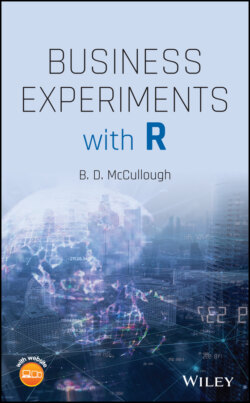Читать книгу Business Experiments with R - B. D. McCullough - Страница 45
1.9 Statistics Refresher
ОглавлениеIf these questions utterly confuse you, you probably shouldn't be reading this book.
Which of the below questions you can answer depends on the statistics course you took. You should be able to answer many of these questions. If you can answer them using the statistical software you already know but not with R, that's okay. We give R code for everything we do in this book. If you can't answer a particular question, don't worry. The methods will be explained as needed later in the book.
1 What are the following percentiles for a ‐distribution?0.900.950.975
2 For a ‐distribution, what value of gives the following proportion in the upper tail?0.010.00050.08
3 What are the following percentiles for a ‐distribution with the given degrees of freedom (df)?0.90, df=100.95, df=200.975, df=30
4 For a ‐distribution with the given degrees of freedom (df), what value of gives the following proportions in the upper tail?0.01, df=100.0005, df=200.08, df=30
5 Use the data in file SR1.csv and perform a two‐sided test of the null hypothesis that for Specifically state the non‐rejection region and the rejection region.
6 Use the data in file SR1.csv and produce a 95% confidence interval for the population mean.
7 For a two‐sided test of the null hypothesis that for , compute power for the one‐sample test of means if the true value of . Assume so that we can use the ‐table, as power calculations with the ‐table are problematic. The data are normal, and let . Compute power if . What can you infer about power? (If your first course didn't use “power,” don't worry about this one.)
8 Use the data in file SR2.csv and perform a two‐sided test of the null hypothesis that for Specifically state the non‐rejection region and the rejection region.
9 Use the data in file SR2.csv and produce a 95% confidence interval for the population proportion.
10 Use the data in file SR3.csv and compute a confidence interval for the difference between two means (hint: equal or unequal variances?).
11 Use the data in file SR3.csv and compute two confidence intervals, one for and one for . Do they overlap? What does this tell you?
12 Suppose that the data in SR3.csv are paired data, i.e. two measurements on the same experimental unit. Let be “before” and let be “after” some treatment. Perform a paired ‐test. Suppose another analyst had done a two‐sample test on these data, as in the previous two exercises. How do the analyses differ?
13 Use the data in file SR4.csv and compute a confidence interval for the difference between two proportions.
14 Use the data in file SR1.csv to make a histogram.
15 Use the data in file SR3.csv to make a scatterplot.
16 Use the data in file SR3.csv to run a simple regression, interpret the coefficients, and test whether the slope equals zero.
17 Use the data in file SR5.csv to run a multiple regression, , interpret the coefficients, and test whether a slope equals zero. (If your first course didn't cover multiple regression, don't worry about this one.) Perform model checking (i.e. check whether the assumptions are true).
18 Use the data in file SR5.csv to run a multiple regression with dummy variables, . (If your first course didn't cover multiple regression, don't worry about this one.)
19 Suppose there is a categorical variable with three levels. Suppose it is “type of house” and it can take on the values colonial, split level, and rancher. How can this categorical variable be represented by dummy variables?
20 Using the file Houses.csv , regress price (in thousands of dollars) on square footage (in square feet), age (in years), and a dummy (yes/no) for whether or not the house has a fireplace. Interpret the output.
21 Using the file Houses.csv , regress price (in thousands of dollars) on square footage, age (in years) and dummies for fireplace (yes/no), and type of house (colonial, rancher, or split level). Interpret the output.
22 Use the data in file SR5.csv to use ANOVA to test the null hypothesis that the means of X1, X2, and X3 are all equal. Perform model checking.
